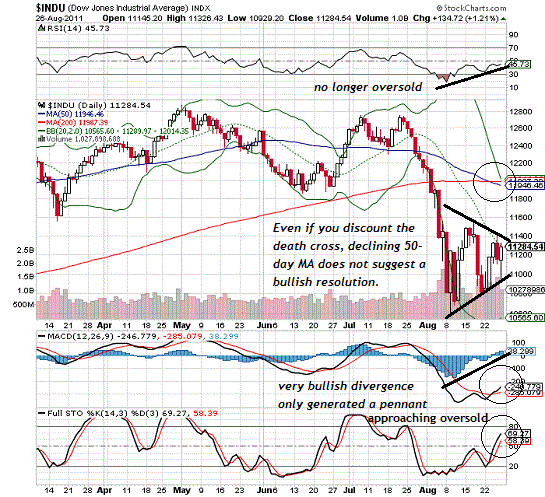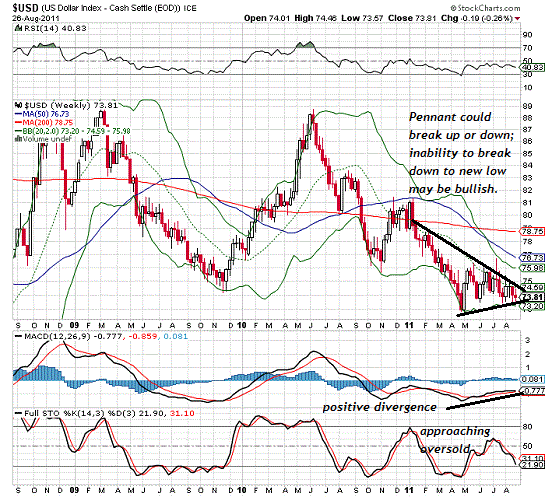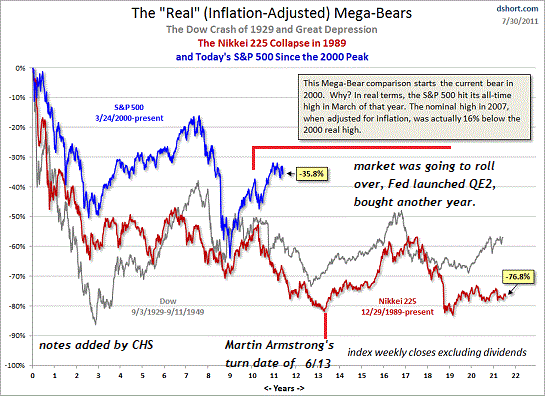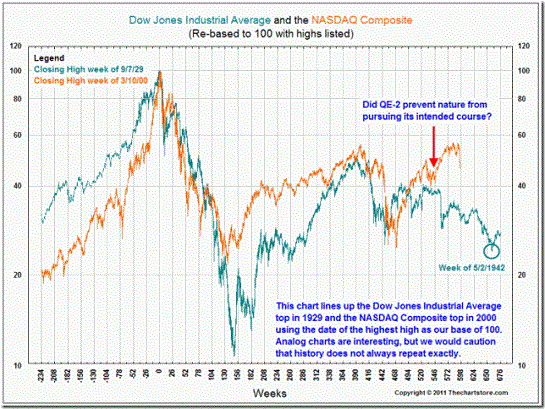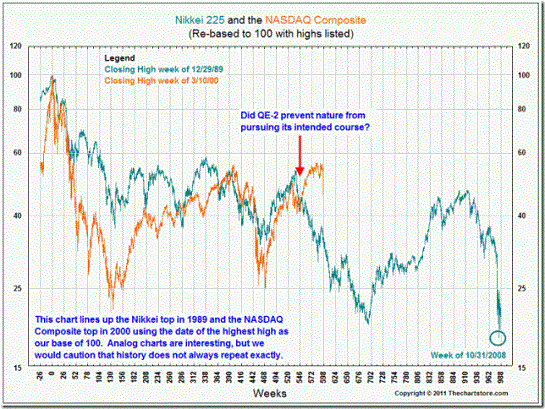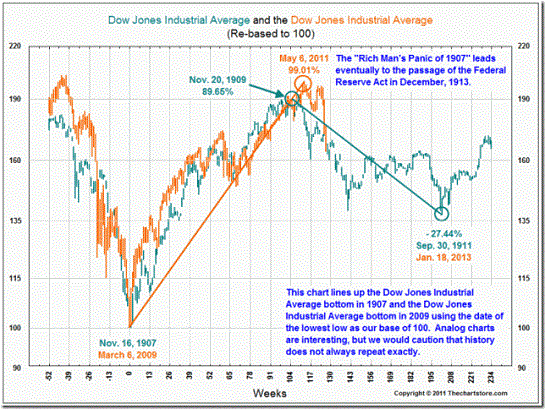We have or will soon have 20-25 million unemployed people with few prospects for a job. This is a problem we cannot and should not dodge just because it's inconvenient to our cargo-cult political Elites. There is a low-cost solution that everyone will dislike.
America has a systemic problem which it refuses to recognize because the usual Left-Right ideologies would all be revealed as complete failures. Here is the problem: there are 15 million officially recognized unemployed, and another 5 million zombie-unemployed who have dropped off the government's tabulation because they are politically inconvenient.
The other half of this problem is that the nation's job-creation machinery is completely broken for structural reasons I have described many times, most recently in You Want to Create Jobs? Here's How (August 2, 2011) and You Want to Create Jobs? Here's How Part II (August 4, 2011).
The hard reality is that the U.S. economy must be re-ordered from the ground up if we are to revive the job-creation machinery. This will require many systemic changes, the two key ones being A) breaking the death-grip of the top 1/10th of 1% financial/political Elite's grip on the throat of the economy and central government, and B) transitioning the entire economy from a bloated, inefficient, rigid, high-cost, crony-capitalist, monopoly/cartel-dominated, credit-based consumerist economy to a productive, capital/savings based economy based on the rule of law, community governance, individual rights and decentralized competition.
The current model of pretend-Capitalism and extend-and-pretend debt consumption is falling apart due to intrinsic, structural reasons. Rather than add jobs, the U.S. economy will shed another 4 to 5 million jobs in the next few years. While our government will gerrymander the statistics, the bleak reality is that there will be between 20 and 25 million unemployed Americans with essentially zero job prospects by 2013/14.
Neither the Left nor Right is willing or able to face this reality. This is because ideologues are like alcoholics; getting drunk every night "works" because it's easier than facing up to failure and wrenching change. Ideologues turn a blind eye to the failures of their chosen political faith because it's easier than facing their failure and having to toss their cherished ideological security blanket on the trash heap of history.
The fervent proponents of Left and Right are all alike in cherry-picking evidence to support their own rigid orthodoxies and ignoring any evidence that the "big ideas" of their faith are not just failures in the real world, but actively pernicious and counter-productive.
If we dare to set aside our ideological blinders for a moment, perhaps we can deal honestly with the reality that the job-creation machinery of the U.S. economy is fundamentally broken. Left and Right ideologues are in effect adjusting the rear-view mirror on a car with a blown engine, hoping that adjusting our view of the past will magically fix the destroyed engine.
Reduced to their essence, the "big ideas" of Left and Right are: government control and spending fixes everything (Left) and lowering taxes and boosting corporate/banker/Wall Street welfare fixes everything (Right).
The Bush Administration squandered trillions of borrowed dollars implementing the Right's "big idea," and the Obama Adminstration has squanderd $6 trillion of borrowed money pursuing the Left's "big idea." Both have undermined the economy and burdened future generations with a criminally large debt/claim on their earnings, yet all we hear from both camps of cargo-cultists is that we didn't do enough of their magic.
They are just like alcoholics who are "gonna quit right after I get drunk one more time." It never happens, because they're in denial and can't bear the pain of their failure.
The job machinery is broken for a lot of reasons, and most of them are not explicitly political. If you are unfamiliar with the concept of "the end of work," please read these previous entries to get an understanding of the global, systemic and technological reasons why the machinery which "worked" during the post-war boom no longer works.
The "End of Work" and the Coming Revolution in Education (June 7, 2011)
End of Work, End of Affluence (December 5, 2008)
End of Work, End of Affluence I: Cascading Job Losses (December 8, 2008)
The End of (Paying) Work (January 21, 2009)
There are eight pages of entries on "the end of work" in my archives; just enter "end of work" in the custom search box in the upper left sidebar to view them all.
What few are willing to discuss is what we as a nation should do with 25 million people with few job prospects in a broken economy. The economy could be fixed, but it will require from-the-bottom-up changes that will up-end all the Elites and fiefdoms which currently benefit from the Status Quo Central State/Cartel-Capitalism partnership.
As a result of the immense power and resistance of these corporate cartels and Savior State fiefdoms, structural change is politically impossible. The only politically "possible" action is to keep adjusting the rear-view mirror on the broken-down car while chanting tired old incantations.
The Right's cargo-cult fantasy is that cutting taxes will create 20 million jobs. The Right is beholden to cartel-Monopoly Capitalism, a.k.a. Global Corporate America, and Corporate America views competition as the one great evil that might limit vast profits. So it has enlisted the Savior State to decimate competition. Whatever can't be quashed is snapped up to preserve the highly profitable monopoly/cartel.
The Mainstream Media loves to hype the story of three college kids who start a multi-million dollar Web 2.0 business in their cramped San Francisco apartment, but as I constantly remind readers, Twitter has about 300 employees and Facebook around 1,700. The reality is that Web 2.0 businesses are all about lowering costs (free software replacing employees) and attracting eyeballs, i.e. marketing, which pulls revenues from old-line media and causes cascading job losses in those industries.
Life is good for the top 1/10th of 1% of America's entrepreneurs, but for real-world small business, prospects are bleak and getting bleaker: Shrinking in a Bad Economy: America's Entrepreneur Class.
I often summarize the reality thusly: you have to be insane to start a business in the U.S., unless you're the proverbial smart kid with a Web 2.0 idea you can monetize in a few years and then sell to Global Corporate America for tens of millions of dollars.
If the ranks of the jobless are set to swell by millions, and the job machinery is broken for reasons that are politically impossible to fix, then where does that leave the 25 million unemployed, and where does it leave the nation?
I have a solution, but since it's practical and doesn't fit every ideologue's narrow view, then everyone will find plentiful reasons to dismiss it, Left, Right and Libertarian alike. So then the question to ideological purists is: what's your solution? Doing nothing doesn't work, cutting taxes doesn't work, and propping up the Corporatocracy with trillions in Status Quo Savior State spending doesn't work, either.
The London riots have triggered avalanches of hand-wringing, stern lectures and pontificating, and at the risk of oversimplification I think we can boil the riots down to a simple but profound concept: the disenfranchised no longer have a stake in the Status Quo or in their communities.
Here is the ugly truth about the Savior State, welfare state, social welfare state, or whatever you choose to call the Central State: The Savior State displaces and destroys community and social capital. By making individuals dependent on the Central State for free money, free food, free housing, etc., then the State has taken over the natural function of community.
Being part of the community is no longer a requisite for social capital, employment or meaning. Free money is not a positive, it is a force of destruction for the individual and the community.
One thing I have noticed about ultra-orthodox Liberals/Leftists: they are rarely self-employed in the private sector, rarely own a small business with actual blue-collar/pink collar workers, and they have little actual experience with the systems they ceaselessly hype as "positive solutions": unemployment lines, emergency rooms, applying for SSI, a.k.a. "crazy money" permanent disability from Social Security, Section 8 housing, food stamps (SNAP), finding a doctor to extend your workers compensation stress claim, or any of the other ways that the "poor" either navigate the system or game it.
The Left's cargo-cult fantasy is that giving tens of millions of people free money is going to "tide them over" until some magical return to 1999 occurs and 20 million jobs arise out of nowhere. Since nobody on the Left has ever started a small business or hired anyone, then the job creation that will someday arrive to save us (cargo-cult!) truly is inexplicable "magic."
On the Right, most of the cheerleaders of lower taxes/cartel-capitalism/Central State spending on Global Empire, etc., are safely perched in some protected fiefdom sucking off the very State they piously deplore. Very few have started and operated a small business from scratch; those few who claim business experience usually inherited the business from their family.
Thus both sets of ideologues are like car owners who are anxious to tell a mechanic how to fix the blown engine even though they've never even picked up a wrench or changed a spark plug.
Here's the deal with humanity: we will exploit whatever windfalls are offered to us.Windfall exploitation is a key concept in Survival+, and it is value-judgment neutral, meaning that it is a trait that has been selected as extremely helpful; saying it's "good" or "bad" is meaningless.
Left and Right ideologues turn a blind eye to the windfall exploitation that doesn't fit their views. If I am a very wealthy person, and I can invest $300,000 in tax attorneys and shell companies that save me $3 million in annual taxes, then that is a windfall I would be foolish to pass up.
If I an CEO of a Global Corporate America company, and spending $3 million in campaign contributions will reap my firm $300 million in tax breaks or government contracts, then I would be foolish to pass up such a windfall.
"Poor" people are no different; if being "poor" is incentivized, then remaining "officially" poor is a modest but very real windfall. If being a single Mom is incentivized, then the obvious choice is to avoid marriage to collect the windfalls that flow to single moms. If workers compensation can be gamed via a "stress claim" for a long "free" vacation, then it's foolish not to exploit the windfall.
The Right is blind to the windfall exploitation of the financial Elite, and the Left is blind to the windfall exploitation of those with access to Savior State free money. Those of us with actual experience in blue-collar/pink-collar America and "poor" communities are keenly aware of this because we know dozens of people who are scamming the system.
The tragedy of "free money" is that the subtext of this "help" is so perversely negative. When you get free money or equivalent, rather than an opportunity to contribute, what you're being told--and recipients understand this quite well--is that you're not worth any real investment or effort. The "free money" is a bribe to keep quiet and invisible. Those skimming the benefits of the Status Quo don't want you pestering them or upsetting the apple cart, so they give out enough free money and goodies to buy everyone off, making them complicit in the whole rotten system. The real message of free money is this: you're worthless.
And because we're designed to take free money, or free anything, we take whatever's free: the $3 million tax break, the $300 million government contract, or the food stamps and unemployment. But there is a cost, of course: in taking free money from the Savior State, as corporate or individual welfare, we have sacrificed our autonomy for our yoke of dependence on a disembodied, distant State.
If we want to get 20 million people back to productive work, we need to incentivize productive work and stop incentivizing unproductive gaming the system. I already laid out some structural steps in You Want to Create Jobs? Here's How (August 2, 2011) and You Want to Create Jobs? Here's How Part II (August 4, 2011), but these are all politically "impossible" at this time.
Maybe in five years things will be different, but in the meantime, what do we do with 20-25 million people with nothing to do? Answer: we put them to work.
Before I describe how, let's be honest about how destructive it is to sit at home doing nothing, contributing nothing and being utterly unproductive. People who are denied a chance to contribute and be part of their community are unhappy people. People without productive work are so unhappy that many people who retire to an unproductive life simply die.
I think the evidence is profoundly obvious that paying people to sit at home watching the telly is profoundly destructive. It is no wonder that people paid to do nothing, people dependent on the Central State for handouts, are filled with resentment; nobody likes to be worthless or dependent, and yet this is precisely what "free money" does to the human spirit.
Free money destroys the value of social capital, community, and the fabric of community, which is responsibility and reciprocity. With Free Money, there is no need to engage in social capital building, because the State check comes regardless.
There is a deeply pernicious political agenda to free money: it atomizes people, and this makes them much easier to control. By issuing individual checks and benefits, the Central State has set up a diabolical social Darwinism, in which competition for entitlements creates a dog-eat-dog environment in which community is discounted to zero and gaming the centralized State bureaucracy is highly rewarded.
Once you discount community to zero, it unravels. Poverty is not just a lack of money, it is a lack of social and human capital, a topic I address in An Unconventional Guide to Investing in Troubled Times.
The only way to restore value to community and social capital is to require every recipient of State welfare/free money/free benefits to contribute time and effort to their community, and cut off the benefits/free money if they choose not to. With choice comes responsibility.
(For obvious reasons, the working poor with full-time jobs drawing benefits would be excluded from community work. The idea is to reward productive work, not punish it.)
Since we're giving people free money and free goods/services anyway, why not enable them to be productive, build social capital and keep their skills sharp, or learn new ones? The net additional cost is essentially zero, as all we'd be doing is leveraging systems which already exist.
This is not "national service," because it's not controlled by the Central State. It is a form of "workfare," which is positive for the individuals being given the choice. Why is workfare positive for the unemployed? The best way to acquire valuable skills and valuable social-capital contacts is to enter the workforce and start doing something productive. Once a person is needed, and contributes something positive to their community, their self-worth rises and the community gains the benefits of their labor.
The transition from incentivizing doing nothing to incentivizing productive labor on behalf of community will be difficult for many; even though it is terribly debilitating to sit at home doing nothing, it is certainly "easy," just like it's easy to live off government contracts (corporate welfare) as opposed to actually having to compete in the real world.
We don't need to reinvent the wheel to put 20 million people to productive work in their communities. There are a million churches, community groups, non-profits, service clubs, garden clubs, etc. in the U.S. (not to mention state and National Parks desperate for motivated volunteer labor). Giving 20 million unemployed a choice of places to contribute to their community would eventually distribute about 20 people on average to each organization.
The vast majority of these organizations are already set up to put volunteers to work. They already exist; there is no vast machinery to invent at the Savior State level. The decentralized machinery already exists to do everything that Global Corporate America can't do for stupendous profits.
As cities, counties and states trim their workforces to align expenses with their tax revenues, then community tasks like maintaining parks will devolve to volunteer groups. Rather than pay 20 million people to sit at home doing nothing, why not engage them in their community, and get them back into the positive world of contributing and being valued?
Those collecting food stamps and Section 8 housing can also contribute, in proportion to the benefits they're accepting. Free anything is debilitating, and it's crazy yo be giving tens of millions of people money to contribute nothing while the nation falls apart out of neglect.
Global Corporate America will only do and only go wherever it can reap staggering profits; that is its raison d'etre. Thus most of the real work of the nation is of zero interest to Global Corporate America and its politico toadies.
Here are the numbers. I have sourced these many times so look in my archives:
Corporate profits: $1.4 trillion, or 10% of GDP.
The Free Money programs: extended unemployment: $160 billion, SNAP food stamps: $60 billion, Section 8 housing vouchers: $10 billion, total around $230 billion, or 8.4% of annual Federal spending of $3.8 trillion, and less than 2% of GDP.
Let's be honest: it's easy to pay people to do nothing. Requiring people to be productive is fraught with challenges: liability issues, oversight, lack of training, and a thousand other problems.
It's easier to pay people to do nothing than give them an opportunity to contribute and improve their skills and social capital.
That's too bad, because the machinery is already in place: we already have a vast system in place for teaching new skills called adult education and community colleges. We have a vast decentralized system in place to serve and nurture communities (community and non-profit organizations), which are ultimately the lifeblood of the nation. We already have a bureaucracy in place with systems for tracking and monitoring unemployed people called the state unemployment system.
Paying people to be idle and unproductive is destructive and debilitating; giving them a chance to contribute and become valued would be hugely positive, for the idle and for their communities. The message would change from: you're worthless, just stay home and fade away, to: you are too valuable to pay to sit at home doing nothing.
I know this idea goes against every ideologically pure ideal out there; it is simply too practical, too cost-effective, too positive and too unrewarding to Central State fiefdoms and Global Corporate America cartels to gain any support from the financial and political Elites.
So instead we'll watch our Elites fiddle with the rear-view mirror to "fix" the jobs machine which has a blown engine and frozen transmission, and as the unemployment lines lengthen by millions, we'll continue paying people to sit at home rotting away and feeling worthless while the country falls apart at the seams. And why? Because it's easier than giving them a chance to be productively useful by contributing to their community.
I am taking a break from posting and email. As I won't be reading correspondence for a number of days, I won't be able to reply to emails. Thank you for your understanding.
What others are saying about An Unconventional Guide to Investing in Troubled Times:
"There isn't a shrewder and more insightful observer of the chaotic, swirling American scene than Charles Hugh Smith. If you are having trouble making sense of your culture, please buy this book!"
--James Howard Kunstler, author of The Long Emergency and the World Made By Hand novels
"Less 'how-to' than how to think, An Unconventional Guide to Investing in Troubled Times is the perfect antidote to the smoke-and-mirrors groupthink that runs rampant on Wall Street. Chock full of insights on accumulating and preserving wealth in a rapidly-changing world, Charles Hugh Smith's latest book is a 'must have.'"
--Michael Panzner, author of Financial Armageddon and When Giants Fall
"For anyone seeking an original, eye-opening, unvarnished and practical approach to the real New Normal, and the capital markets that accompany it, Charles Hugh Smith, one of the very few voices in the noisy wilderness of the financial Internet worth listening to, has just released this must read book for anyone who wishes to learn about the other, and more importantly correct, side of the story."
--Tyler Durden, Zero Hedge
"A masterful synthesis of essential insight and practical guidance. This Unconventional Guide explains why our economy and financial markets have reached a level of unsustainable systemic risk -- and how understanding the nature of the forces at play enables savvy strategies for securing 'wealth' (of all kinds) as the inevitable dénouement unfolds. Few authors write with the intelligence and heart that Charles does; fewer books empower the reader more to face the certain changes in our future with confidence."
--Chris Martenson & Adam Taggart, proprietors of ChrisMartenson.com
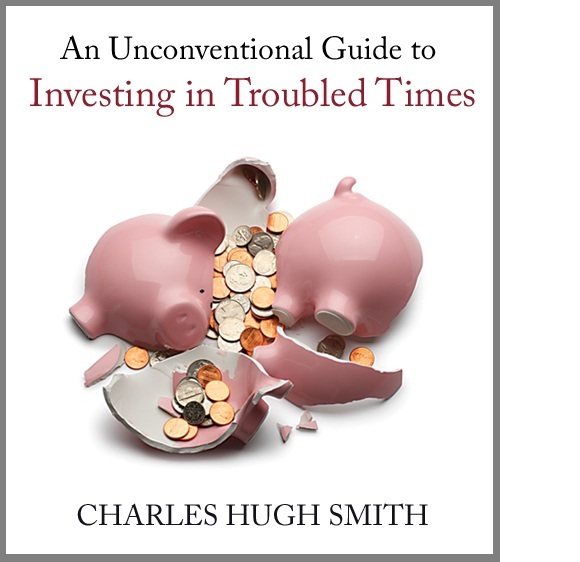
If you have some doubts about Wall Street's permanently Bullish "guidance," you might be interested in my new book An Unconventional Guide to Investing in Troubled Times, now available in Kindle ebook format. You can read the ebook on any computer, smart phone, iPad, etc.Click here for links to Kindle apps and Chapter One.
Readers forum: DailyJava.net.
My new book An Unconventional Guide to Investing in Troubled Times is available in Kindle ebook format. You can read the ebook now on any computer, smart phone, iPad, etc. Click here for more info about Kindle apps and the book.
Order Survival+: Structuring Prosperity for Yourself and the Nation (free bits) (Mobi ebook) (Kindle) or Survival+ The Primer (Kindle) or Weblogs & New Media: Marketing in Crisis (free bits) (Kindle) or from your local bookseller.
Of Two Minds Kindle edition: Of Two Minds blog-Kindle
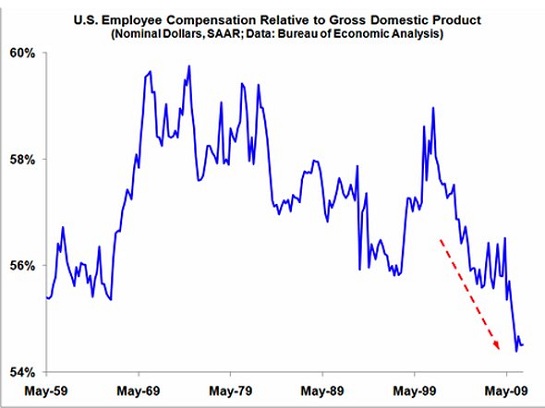
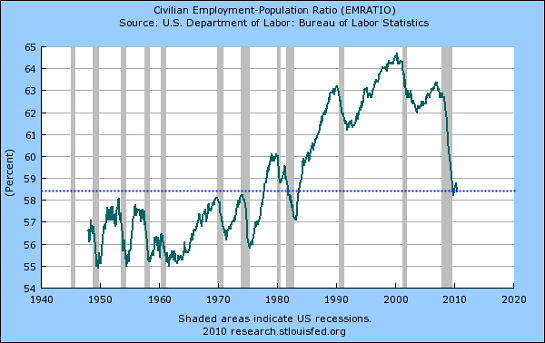
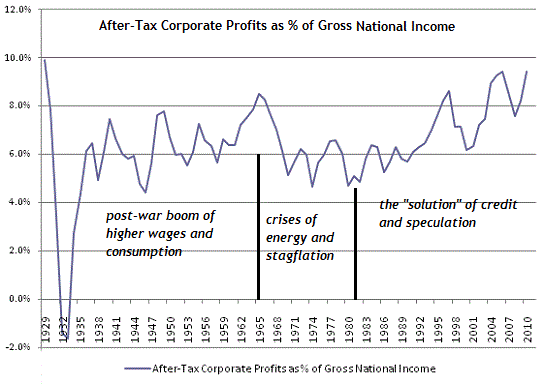
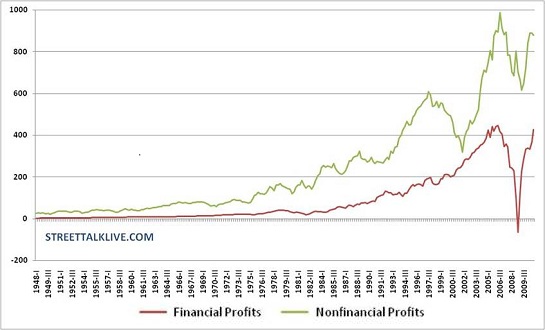
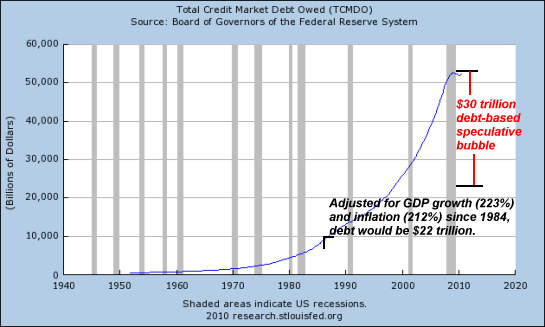
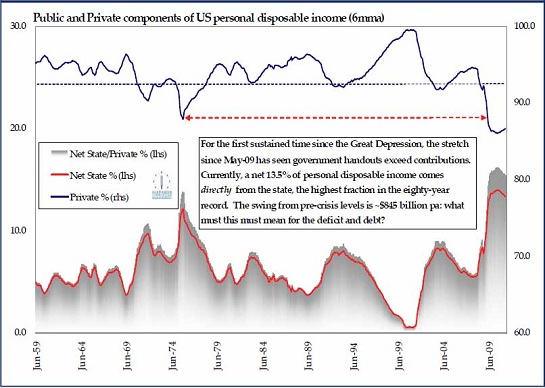
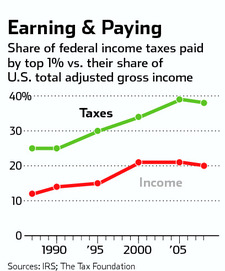





















 The engineers at Volkswagen have been working on their Car of the Future for years, the so-called
The engineers at Volkswagen have been working on their Car of the Future for years, the so-called 
